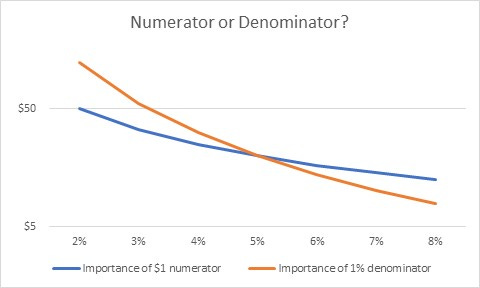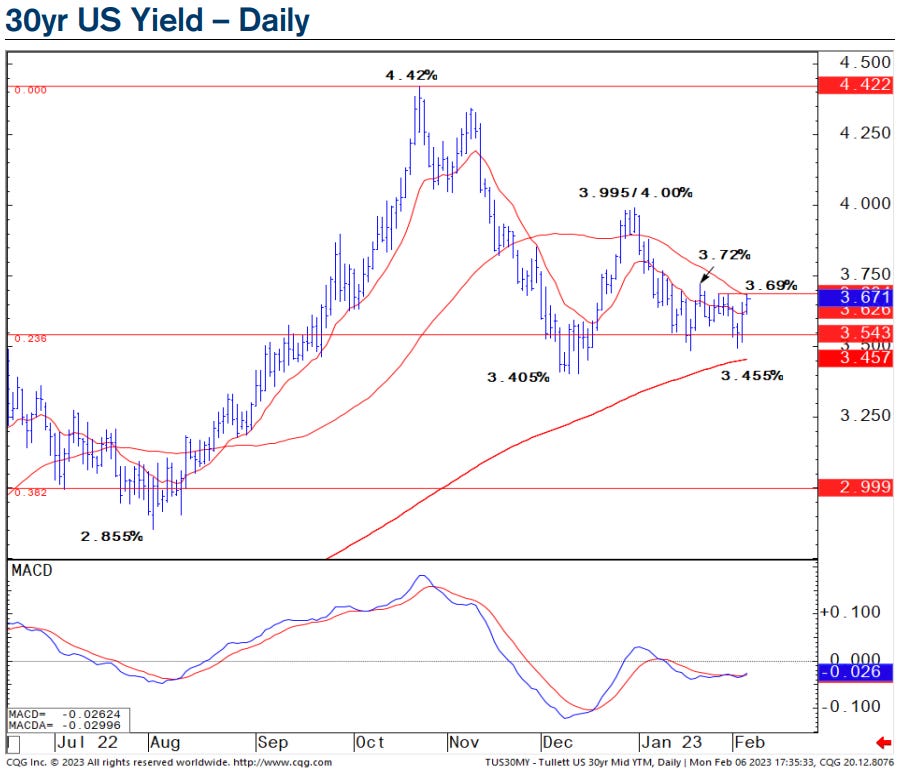(mixed / steeper on above avg volumes)while WE slept; "...the bond traders are still the cool kids."
Good morning … This afternoon just AFTER JPOW speaks (12p - 1240p), we'll get privilege of helping Yellen’s Dept of Treasury begin her refunding with this afternoons 3yr auction … On THAT note, here are a couple looks at 3yy
(momentum oversold as we’re breaking above a TLINE established back in Oct)
(same idea but on WEEKLY time frame, momentum only just crossed BEARISHLY)
Can’t WAIT to see what the market says / does with today’s 3yr (and the weeks duration dump) but, for now … here is a snapshot OF USTs as of 7a:
… HERE is what another shop says be behind the price action overnight…
… WHILE YOU SLEPT
Treasuries are mixed with the curve pivoting steeper off a little-changed long-end this morning. Aussie bonds were a drag (3yrs +15bp) after a hawkish 25bp RBA hike while Gilts underperform bunds and Treasuries this morning. DXY is little-changed ahead of a Powell speech at lunchtime while front WTI futures are higher (+1.75%). Asian stocks were mixed, EU and UK share markets are little changed while ES futures are basically FLAT here at 6:30am. Our US rates flows during Asian hours saw a rebound in prices despite the RBA and the dead-low closes in NY just hours earlier. Desk flows saw better buying in intermediates with strong out-performance noted in the front-end alongside two block clips in TY's that looked like buys. Overnight Treasury volume was very solid at ~175% of average overall with the relative volume leader being 7yrs (447% of ave), matching our flows and the block activity.… At the other end of the curve, Treasury 30yr yields remain rangebound, swilling umbrella drinks while wondering what all the fuss is about. Which brings us to the yield curves, naturally...
… and for some MORE of the news you can use » IGMs Press Picks for today (7 FEB— and STILL SPORTING THAT NEW LOOK!!) to help weed thru the noise (some of which can be found over here at Finviz).
From some of the news to some VIEWS you might be able to use. Global Wall St SAYS:
First up one which hits particularly close to home … Mike Ashton the self proclaimed inflation guy with a hard hitting essay noting,
… Let’s think about the stock market. For many years now, the stock market has acted as if what the Fed does is far more important than what the businesses themselves do. And you know what? Investors were probably being rational by doing so. At low interest rates, the change in the discount rate was far more important – especially for companies that don’t pay dividends, so they’re valued on some future harvest far in the future – than changes in company fortunes.
However, as interest rates rise this becomes less true. As interest rates rise, investors should start to care more and more about company developments. I don’t know that there is any magic about the 5% crossover that I have in that chart (the y-axis, by the way, is logarithmic because otherwise the orange line gets vertical as we get to the left edge!). But it suggests to me that stock-picking when interest rates are low is probably pointless, while stock-picking when interest rates are higher is probably fairly valuable. What does an earnings miss mean when interest rates are at zero? Much less than missing on the Fed call. But at 5%, the earnings miss is a big deal.
Perhaps this article, then, is mistitled. It isn’t that we are all bond traders now. It’s that, until recently, we all were bond traders…but this is less and less true.
And it is more and more true that forecasts of weak earnings growth for this year and next – are much more important than the same forecasts would have been, two years ago.
But the bond traders are still the cool kids.
Thanks … Thanks for that daily affirmation, Mike … On TO DBs Jim Reid for whatever it was that happened yesterday,
… Markets got the week off to a "scary spice" start yesterday, with bonds and equities both soft, especially bonds. That was driven by growing doubts among investors about whether inflation would come down as hoped over the coming months, which in turn saw them price in a much more aggressive pace of rate hikes from central banks. Indeed, expectations of the Fed’s terminal rate for this cycle hit the first new high of the cycle since early November with the July contract ending yesterday with an implied rate of 5.157%, up from 4.81% at the recent lows last Wednesday. Indeed we’ve seen a full 25bps rate hike added to market pricing (and a bit more) since the jobs report came out on Friday. December 2023 contracts were up another 20bps yesterday and are now +48.5bps since just before the payroll report.
Goldilocks on some of the DATA out late yesterday,
BOTTOM LINE: The Federal Reserve’s January 2023 Senior Loan Officer Opinion Survey—conducted for bank lending activity over the fourth quarter of last year—reported that standards tightened and demand weakened broadly for commercial and industrial loans for firms of all sizes as well as for all types of commercial real estate loans. On the household side, banks also reported weaker demand on balance for credit card, auto, and residential real estate loans, as well as for home equity lines of credit.
Goldilocks updating views on (abating?) recession risks
We have cut our subjective probability that the US economy will enter a recession in the next 12 months from 35% to 25%, less than half the 65% consensus estimate in the latest Wall Street Journal survey. Continued strength in the labor market and early signs of improvement in the business surveys suggest that the risk of a near-term slump has diminished notably. And while Q1 GDP still looks soft—our latest tracking estimate is +0.4%—we expect growth to pick up in the spring as real disposable income continues to increase, the drag from tighter financial conditions abates, and faster growth in China and Europe supports the US manufacturing sector.
We Now See Only 25% Odds of a US Recession in the Next 12 Months, Well Below Consensus
… Taken together, these observations support not only Chair Powell’s optimism that a soft landing is achievable but also his insistence that the Fed’s job is not yet done. Our baseline forecast calls for 25bp hikes at the FOMC meetings in March and May, followed by about a year of unchanged rates at 5-5¼%. Our probability-weighted path for the funds rate—which incorporates the downward revision in our near-term recession probability—thus remains above market pricing…
For somewhat MORE and a bit of defense from another angle, the firm writes,
Corporate Layoffs: A Ripple, Not a Wave
… One concern that is often raised is that the recent layoffs have been concentrated in particular industries, especially technology, while hiring has been concentrated in other industries, often lower-paying ones. We find, however, that job finding rates are above pre-pandemic rates in most industries (including information, which includes technology companies) and above expansion norms in all major industries, and that job openings rates remain above the pre-pandemic level in every major industry except information.
… We would become more concerned about undue labor market deterioration if we began to see elevated layoffs in industries where job finding rates were particularly low. In such a scenario, the increase in the amount of time that it takes unemployed individuals to find a new job would weigh on consumer spending and as a result spill over to other parts of the economy. For now, this is not a major concern because the job openings rate remains above the pre-pandemic level in every major industry outside of
Don’t worry, be happy … the news of layoffs in tech aren’t representative of much to worry ‘bout … Party on, Wayne!?
A large British operation spotting an interesting divergence,
Thinking Macro: The jobs puzzle in US housing
Home sales and housing starts have collapsed over the last year, as mortgage rates have risen. And yet, construction employment has held up remarkably well, and might continue to do so.… This story is not fully written, of course. Despite all the reasons mentioned above, there might eventually be some job losses in the construction sector if mortgage rates stay at these (still high) levels. But, given signs that housing activity has bottomed and is now edging back up, it now seems very likely to us that we never see effects on housing employment of the magnitude that the Fed was probably banking on. If we do not, and the jobs market does not cool down quickly, it will likely force the Fed to stay aggressive for that much longer.
And ahead of JPOW, a few words from Ed VIGILANTE Yardeni,
Fed Chair Not Likely to Stir Things Up Tomorrow
… Bottom line: What this all means, according to Powell, is that the FOMC will vote on “a couple of more rate hikes to get to that level we think is appropriately restrictive.” That would put the federal funds rate range at 5.00%-5.25% by early May assuming (as Powell suggested) two more 25bps hikes at the next two FOMC meetings. The FOMC then intends to keep it there until inflation falls to 2.0%. By the way, Powell mentioned the word “restrictive” in this context 10 times during his presser.
With that in mind, 1stBOS offering a look at 5yy as their FI CoTD,
… Chart of the Day: US Rates markets continued Friday’s bear flattening move as terminal rate pricing was reassessed and cut pricing for 2023 was reduced. With important levels broken in US 2s and 5s, we see scope for this dynamic to continue further in the coming days. The latter has broken its range highs at 3.695%, as well as the 55-day average at 3.735%, after repeatedly holding the 200-day average at 3.455%. In our view, this suggests a retest of psychological support at 4.00%, with a key yield high at 4.035%
The firm acknowledging the market has dictated they move to sidelines getting neutral 5yy (from being tactically bullish) and yet they remain steadfastly and tactically bullish 10yy (from ~3.85%) with a move above 4% making them consider turning neutral and with regards to the longer end, well,
… Short-term Strategy: We initiated a tactical bullish bias at support at 3.85%, and see scope for a fall to 3.00%, where we would consider turning tactically neutral. Support is seen at 4.00%, above which we would also consider turning tactically neutral.
Finally, before hitting send and popping the corn into JPOWs afternoon speech, FRBSF economic letter attempting to answer the question on many of our minds with regards TO financial conditions,
Financial Market Conditions during Monetary Tightening
The current round of federal funds rate increases is expected to reverse a historically large gap between the real funds rate and the neutral rate at the beginning of the tightening cycle. Financial markets have reacted faster and more strongly than in past monetary tightening cycles, in part because of this large gap and the Federal Reserve’s forward guidance. Historical experiences suggest financial conditions could tighten even more given the size of the gap.
Lets see what, if anything JPOW has to say about financial conditions or if he’s simply focused like a laser beam on the employment situation … THAT is all for now. Off to the day job…









